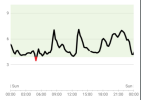Hi Simon
@NewDawn,
Sorry I couldn't reply yesterday, lots going on at home just now as our daughter & family are about to move out (on Sunday, fingers crossed) taking most of the contents of this house with them to their new home and inevitably there are numerous little things to be untangled and sorted after 13 months of the 5 of us co-habiting (pragmatic solution).
No, it doesn't necessarily take long to get usable results, with minimal wasted strips. Some people struggle to get a drop of blood, some struggle to get the strip to to draw that drop of blood away and give a reading. For both those sets of people it can make the fp testing business frustrating and stressful - and stress elevates one's BG. So there is benefit in having that routine mastered as an easy background task.
I still feel it's best to have some background awareness of what your fps (taken as part of a structured testing regime) look like, to get the most out of the free sensor. If, of course, that nominal £50 expense is no big deal to commit to fortnightly anyway, then my concerns about getting best value from that first sensor diminish in terms of what is important to you.
However, I would also most gently point out that managing Diabetes is a marathon which can be contradictory, confusing and challenging. And YOU are just on the cusp of pre-diabetic according to a single HbA1c result. So that marathon may (or may not) be somewhere ahead of you. Others have already pointed out that even that single reading could be misleading. You have just turned 60, are a great weight, already look after yourself with healthy eating and staying fit, have very moderate alcohol consumption; and seen from this distance (and I am not remotely medically qualified) it is a surprise to me that you are even at risk of becoming a T2 diabetic. Setting aside
@rebrascora's sensible observation that some leeway should rightly be made for age (as she explains) I do think after reading again this full thread that
@Docb has made a great suggestion. Carry on with rhe modest adjustments you have already recently started but otherwise do nothing more and get a fresh HbA1c in 3 or 6 months time. As
@everydayupsanddowns frequently observes to others Diabetes is a slow moving foe. You would be on the moral high ground to ask your GP to retest you in a while; after all if that result had been 48 or more (ie just actually diabetic) the NICE protocol would definitely call for a 2nd test to confirm that initial diagnosis. So if your GP should say no retest for another 12 months (a possible response) you could make a case for sooner.
You are "at risk" but by no means actually diabetic according to one isolated result. You "could" be Thin Outside and Fat Inside (TOFI) with visceral fat causing your pancreas to work harder than necessary - but you could just have an "outlier" result. I absolutely commend you for taking this result seriously and not just ignoring it; but I also most courteously suggest your natural and commendable instinct to make changes and get into monitoring outcomes from those changes is perhaps too enthusiastic right now. I see nothing wrong with being aware and thus being sensible about your lifestyle in the future, without perhaps slightly over reacting.
If I may, an observation about blood glucose numbers from either fps or CGM. The tech for either displays readings to within 1 decimal point in mmol/L. But that accuracy is totally unrealistic. The hardware for either is kept to a low cost to make it fairly widely available in a potentially quite small market. The software (or physics and chemistry for fps) is also quite subjective by the manufacturers. You could have 2 different test meters, each with their unique strips, and get quite different results from the same finger in the same minute (even from the same punctured point). At best both fps and CGM readings should be rounded up or down to the nearest whole number AND much more importantly just seen as an indication of trend for BG change. For fps you are hoping to confirm that your body successfully managed a meal by keeping the initial (inevitable) increase from first mouthful to within modest limits at the 2 hr point. From the 2 readings at one meal you steadily acquire a sense of what foods suit you overall. For CGM the helpful graph displayed on a mobile phone app or the manufacturer's reader is best seen as just that - a graph, without scrutinising precise numbers and trying to extract detailed conclusions that don't exist. Yes, CGM can be really helpful for T2 management; but I struggle to see a justification for pre-diabetic use (but perhaps that just me being overly frugal.
I encourage you to go and read this article
https://www.cogniteq.com/blog/telemedicine-video-conferencing-complete-overview which is about Telemedicine Video Conferencing, which will be useful for those interested in medicine and technology.
Anyway, bottom line: if you are happy with getting successful fp results, it's wholly your call whether you start the trial CGM tomorrow, or later once you have specific food or exercise questions you'd like to find an answer to, that fps don't reveal. CGM will always need a certain amount of fp results initially to get some reference points. I think
@Phil P's point at post#47 ["Once you have a baseline of a few weeks you could then try the Freestyle Libre 2+ or Dexcom ONE+ and see how well everything matches"] makes total sense. But I gently suggest you don't need to do anything more for now; just get a 2nd HbA1c in a few months time. Then take stock.


